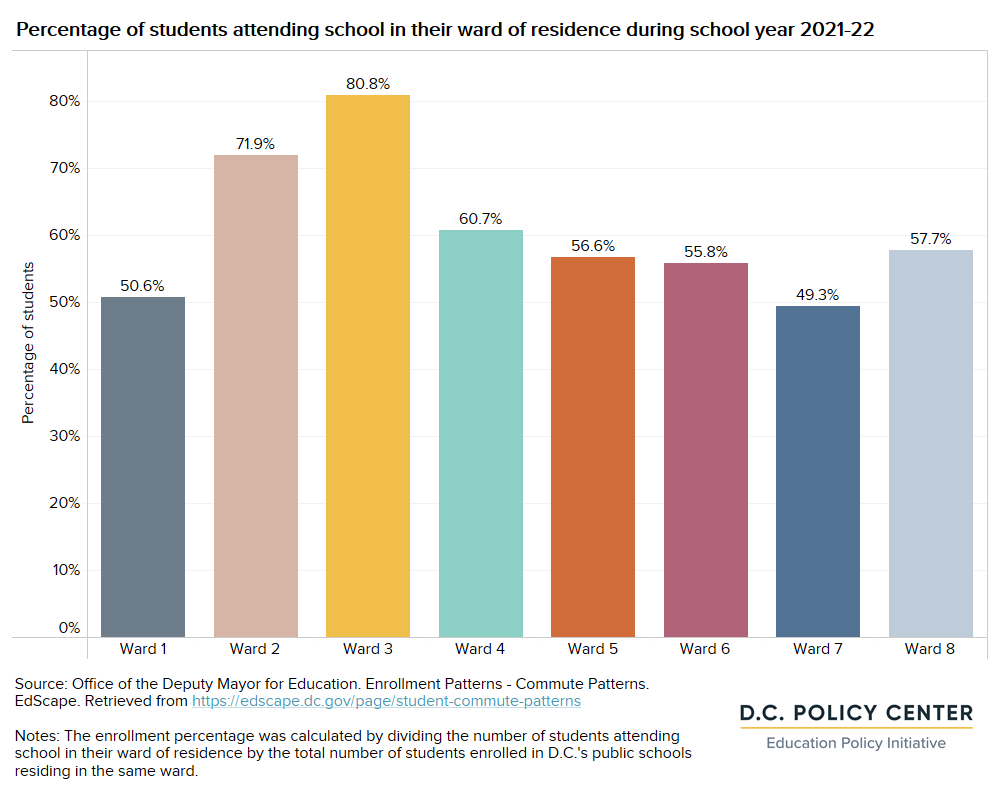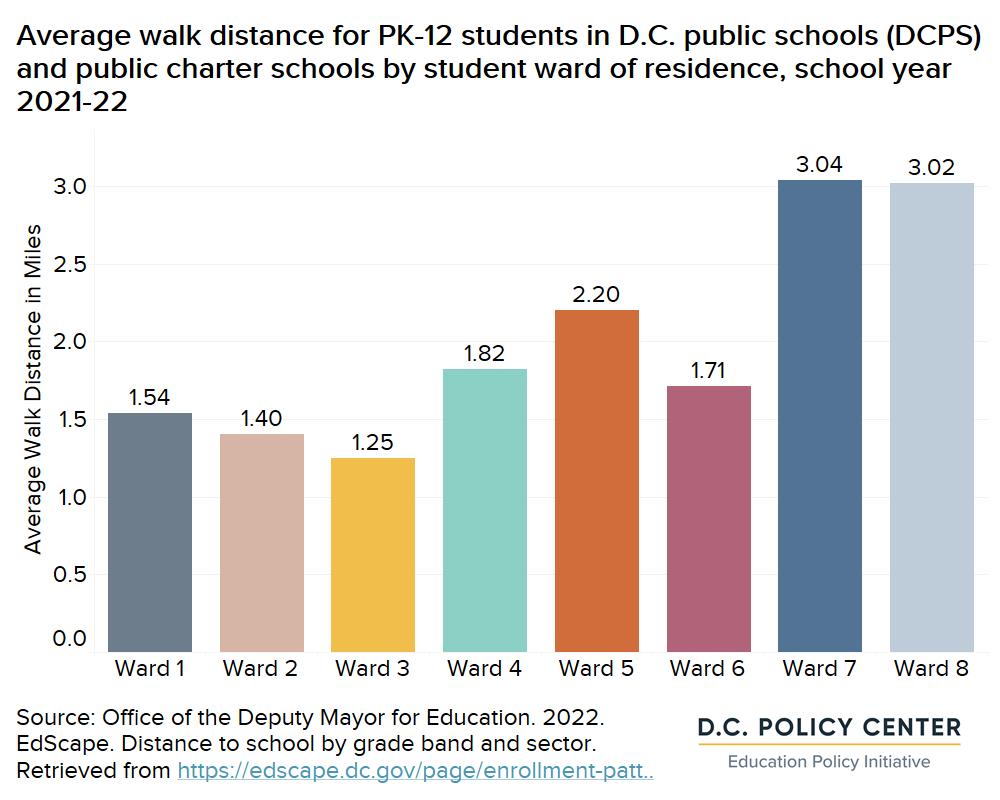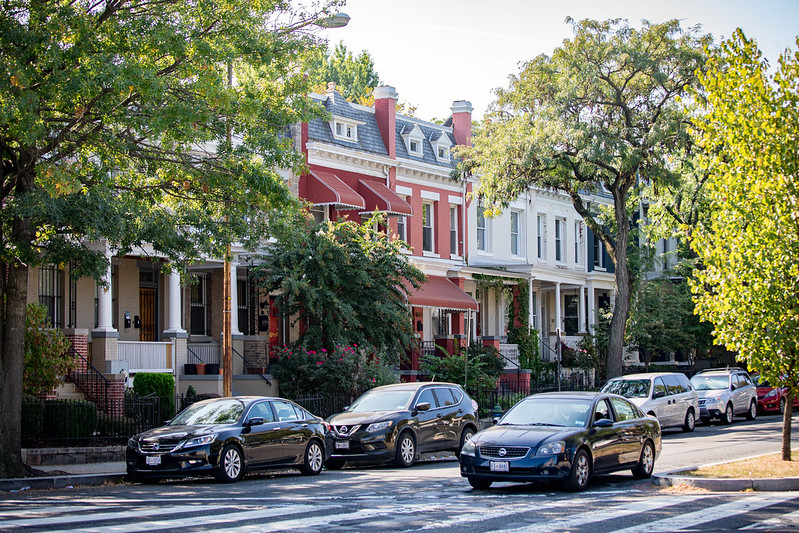
A recent increase in violent crimes across the District has amplified concerns about community safety, including for students on their commutes to school. To improve student safety on their way to and from school, the Safe Passage program places trusted adults from the community along specific routes. Mayor Bowser’s office allocated more than $4.3 million to community organizations to hire 215 Safe Passage workers during Fiscal Year 2022. In order to better understand the program’s reach and impact, we reached out to students, businesses, and administrators to ask about their perceptions of safety for students during their commutes, and what experiences they have had with the Safe Passage program.
Student safety while commuting is a concern for many students, with a lot of students reporting that they do not feel safe during their commute to and from school.[1] In a survey conducted by the Office of the Student Advocate in school year 2019-20, 36 percent of students replied that they felt uncomfortable or in danger while traveling to school.[2] Even for students who said they felt safe, follow-up conversations identified challenges that students felt while commuting, including experiencing harassment or fear due to adults who are perceived as threats along their commute route, fears of fights or gun violence, and a general sense of uncertainty or needing to be hypervigilant. A report from the DC State Board of Education’s (DC SBOE) Student Advisory Board for school year 2020-21 included recommendations to improve safe passage so that students feel safe while commuting to and from school. The report also highlighted concerns around violence and harassment.[3]
Feeling safe while commuting is a high priority, especially as many students in D.C. travel outside of their ward to attend schools across the city. In school year 2021-22, approximately 43 percent of pre-kindergarten through grade 12 students in D.C. traveled outside of their residential ward in order to go to school. Students travel out of their ward of residence to attend schools at different rates depending on where they live: Students in Ward 3 are more likely to attend a school in their ward of residence compared to students in Wards 1 or 7, where half of students travel to other wards to attend school.

Distance traveled to school also varies for students based on their grade band. For elementary grades, the average walk distance in school year 2021-22 was 1.9 miles; for middle school, it was 2.53 miles, and for high school grades it was 3.2 miles.[4]
On average across all grade levels, students in Ward 7 and Ward 8 travel, on average, more than three miles in order to get to school. While in Wards 1-6, students travel on average two miles in order to get to school. Traveling longer distances prolongs the amount of time that some students may be feel unsafe while commuting.

One way of addressing student safety while commuting is D.C.’s Safe Passage Program. Founded citywide during the 2017-18 school year, the Safe Passage Program places trusted adults from the community along specific routes to ensure that students get to and from school safely.[5] Marco Clark, the founder of Richard Wright Public Charter School, and an advocate for the Safe Passage Program, started an earlier version of the program at his school because he was concerned about student safety. “Kids are getting beat up on their way home,” he said. “The bigger the presence of adults, the lower the crime.”[6]
In school year 2022-23, the Safe Passage Program’s eight priority areas were primarily based in Wards 5, 7, and 8, with several additional schools added more recently in Ward 4.[7] The priority areas were chosen based on an analysis of student-involved incidents using data from Metro Transit Police Department (MTPD) and input from a Safe Passage working group in 2017. The priority areas include clusters around the following Metro stations: Minnesota Ave, Anacostia, Columbia Heights, Congress Heights, Good Hope Road SE, Noma- Gallaudet U, L’Enfant Plaza, and Waterfront.
Since its inception in 2017, D.C.’s Safe Passage Program has expanded to 47 schools. In December 2021, Mayor Bowser’s office allocated more than $4.3 million from the Office of Out of School Time Grants and Youth Outcomes during Fiscal Year 2022 to organizations based in the community so that they could hire at least 215 more Safe Passage Workers.[8]
To complement safe passage routes, the Mayor’s office also issued $6.2 million to DC School Connect during FY22, a shuttle service for students in grades 1-12. This shuttle service works with schools in Ward 5, 6, 7, and 8 but is mainly based in Wards 7 and 8. Each school is able to select three locations designated as pick-up and drop-off locations for the students. Additionally, in Fiscal Year 2023, the Out of School Time Office (OST) and the Deputy Mayor of Education (DME) is awarding up to $1.5 million in grants to nonprofit organizations that have experience in providing youth programming for the Safe Passage Safe Blocks program.[9] The program will increase the number of student safe routes and provide funding for afterschool programming focused on conflict resolution skill-building.
While the Safe Passage Program continues to expand in scale across D.C., there is not a lot of information on how students feel while they are commuting and how the Safe Passage Program goes day-to-day. To find out more, the D.C. Policy Center reached out to students, administrators, and community partners to ask what their perception of safety is for students when they are commuting to and from school and what experiences have you had with the Safe Passage program.
Aniyha Brown, Junior, School Without Walls
My perception of safety is that I am never safe until I set foot into my house. Growing up in D.C., I hear about so many missing girls in the area as well as girls getting harassed on the way to and from school. I live in Ward 8 which is one of the wards with an increase in violence. Because my mom does not trust the world around me to have me walk 10 minutes to a bus stop, I get dropped off at my Metro stop. I go to School Without Walls in Ward 2, so when I walk to school from the train station, I am not as worried because there is always a surge of students also walking to school. When the day has ended and it is time to go back home, I often walk to the train station with my friends. From my Metro stop, I walk to the bus stop and take the bus home. On the bus, I read or listen to music because I feel safer while there are more people around me. But, once I’m off the bus, I have a 10-minute walk to my house so I make sure to keep my keys in my hand, my mother on the phone, as well as constantly checking my surroundings.
The Safe Passage Program started in 2011. However, despite going to Ward 7 for elementary school, and Ward 5 for middle school, I had never heard about Safe Passage. The only programs that I had that were close to the Safe Passage Program are afterschool programs such as the YMCA and the Boys and Girls Club. These programs ensured that I was at a safe location with other students participating in fun activities until one of my parents could pick me up. I only became aware of the Safe Passage Program recently during my summer internship at the D.C. Policy Center.
Jamia Hardy, Junior, Benjamin Banneker Academic High School
I want to be able to walk from and to school without fear of being harmed. My hope perception of safety for myself and my classmates is to be safe in your neighborhood.
When I go to school, I use the Metro. I feel safe going to school because my guardian drops me off at the Metro station. Most of the time, the Metro feels secure. I know that security officers are stationed at most metro stations in the afternoon to keep students and other passengers safe. During after-school hours, I believe there should be more officers stationed outside of Ward 7 and Ward 6 Metro stations. I feel very uncomfortable coming home from school because of the people in the metro and in the neighborhood who I don’t know.
I take public transport home with my friends, which makes me feel a lot safer. I am also picked up from the metro rather than taking the bus home from the metro stop. Taking the bus makes me feel uncomfortable because of the catcalls I hear from men and seeing people who are drug addicts sleeping on the bus. Many other students, some younger than me, have been forced to walk home or take the bus. I know many people feel unsafe.
More school buses should transport students home from school or to nearby locations such as the library or recreation centers. In many middle and high schools, I’ve learned, that the safe passage program has been addressing these concerns. For many additional District schools, safe passage should be implemented. The initiative will undoubtedly help a lot of students, in my opinion. Although I haven’t personally used Safe Passage at Benjamin Banneker High School, I believe that many of my friends would benefit from it when going to and from school. I’ve learned more about the safe passage program thanks to my summer internship at the DME building, many of which have already been implemented in my neighborhood. I am eager to follow the safe passage program’s development.
Brooklynne Payne, 10th Grade, Dunbar High School
Personally, I sometimes feel unsafe while traveling to and from school. I usually feel unsafe because of the people around me or the location. In some cases, I have to take routes to and from school that are not ideal because they could be dangerous for me to take, particularly because of the people who are usually on those paths (alley ways, etc.) I don’t fear too much crime/violence in my neighborhood because I live uptown, but I feel for my friends even more because of the different environments we live in, so I think I’m split on traveling to school. Sometimes it’s fine, and sometimes it’s not.
I attended a meeting with DC Safe Passage a few months ago as part of a community service program, and prior to joining, I had never heard of or seen D.C. Safe Passage. Following the discussion, I began to notice more Safe Passage workers outside of my school and on the streets connecting to the school. I thought it was cool that they stood outside to ensure that kids arrived at school safely and without harm. One flaw or disadvantage of this is that I’ve only ever seen them near schools. Traveling further away from school is not monitored because the workers are only near the schools. Also, I noticed that there were far more DC Passage people in one location than another. For example, I went to Dunbar High School and saw many different workers there on my way to school. I went to H.D. Woodson High School one day and didn’t see a single D.C. passage worker. If I could put them somewhere, I’d put them in SE/SW rather than uptown because that’s where a lot of things happen. I like the D.C. Safe Passage program and what they’re attempting. I honestly felt better when I started seeing workers around my school because it provided some comfort.
Bertha Tucker, Tucker’s Child Development Center
My business, Tucker’s, got involved in the Safe Passage Program because we want students to feel safe and secure, and we want them to know that someone will help them in they encounter a problem. We, as instructors, would want someone to help our own children if they needed help. We want students to know that help is on the way because we are there to assist in any and all emergencies. We hope that students will relay this information to their parents too. Although we have been involved in the Safe Passage program for many years, we have not encountered any situations where a student needed help. We remain always watchful and on the lookout for any suspicious activity.
Office of the Deputy Mayor for Education
Safe Passage is Mayor Muriel Bowser’s signature investment to protect students as they travel to and from school, and in the community. It is comprised of three signature programs – Safe Passage Safe Blocks (SPSB), DC School Connect, and Safe Passage Safe Spots.
The School Safety and Safe Passage Working Group identifies priority areas and corridors of the city to deploy our workers and support school communities where students are most likely to experience violence during their travels to and from school. The Office of the Deputy Mayor for Education (DME) and our partners track and measure from our public safety agencies, such as the number of youth-involved incidents of violence before and after-school to inform our Safe Passage Priority Area selection. We also track ongoing operational metrics like the number of incidents our community-based organization partners prevented or de-escalated, conflict mediation sessions they participated in, and the number of SPSB employees who are from the neighborhood in which they work. For this upcoming school year, we have added a new Safe Passage area in Ward 4 based on feedback from the community and data from our public safety partners.
Over the past year, we are particularly excited about Mayor Bowser’s investments to create additional youth safety programming through the SPSB program and DC School Connect. Through SPSB, we have partnered with community-based organizations to hire and place trained, trusted adults along priority routes to ensure students can travel safely to and from school. These adults are trained in community relationship-building and conflict resolution and mediation. They also work in schools to take a preventative approach in building students’ own skills to de-escalate situations. As a result, we have hundreds of Safe Passage workers deployed throughout the District in their signature green vests, including workers such as Sade’, Boye, and Julius from Yaay Me. Having these trusted adults along our streets has made a real difference in the communities they serve, and we have been thrilled to see students and families embrace Safe Passage workers.
With DC School Connect, which launched last school year, we have established a brand-new micro-transportation program, which is now serving over 30 DCPS and charter schools in Wards 5, 7, and 8. Vans are used to provide student transportation to and from school with “microstops” near each school. We are expanding this successful model and encouraging additional families to sign up this school year.
Finally, the District has partnered with local businesses, government agencies, and faith-based organizations to serve as neighborhood “Safe Spots.” These sites serve as safe havens in the community for students where they can go if they feel threatened or are at risk of experiencing violence.
Through all of this work, making sure our students are safe, and feel safe, is our highest priority. We know we have work to do in this area, which why we are deploying measures to support students in school, in transit, and in community. We are addressing this critical issue with a mix of preventative strategies, like social-emotional learning and school-based mental health supports, and interventions, like de-escalation, conflict resolution and mediation. Our ultimate goals through Safe Passage are to ensure student safety during their commute, engage the community to address safety concerns, and employ local District residents.
